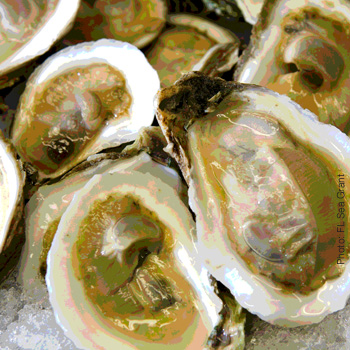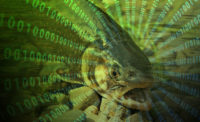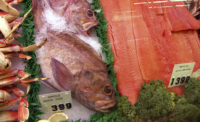Seafood is the most traded food in the world,[1] and such distinction brings both challenge and opportunity, as recently witnessed in the U.S. Gulf of Mexico.[2] The seafood industry is open to significant risk and uncertainty with its complex supply chain in which multiple shipments become one finished product and extensive transformation and aggregation occur through numerous handoffs between harvest and consumption. As information surrounding such complexity grows exponentially, the ability to access, manage, and share such information is critical to mitigating risk, whether at the supplier, buyer or consumer level. The current antiquated mass of documents associated with seafood products has resulted in daunting data overload. These data challenges continue to make it difficult to improve business operations and alleviate risk. Utilizing electronic traceability (e-traceability) with data intelligence can help the industry to digest and manage the vast volume of data and move to a proactive paradigm, in which actionable data being used to prevent problems is the norm and inefficient, expensive, after-the-fact approaches are the exception. Implementing such a system is possible, and there are many opportunities to overcome current obstacles and improve the bottom line from boat to plate. In the Gulf, after multiple disasters (e.g., Katrina and Deepwater Horizon), more than 1,000 unique seafood businesses have voluntarily interacted with a multifaceted e-traceability system called Gulf Seafood Trace (GST) in an effort to improve the market for Gulf seafood.
Value Proposition and Challenges for Gulf Seafood
The bounty of the Gulf has historically supplied the United States with a significant portion of the nation’s domestically landed shrimp, oysters, crab and finfish. Gulf seafood has a unique value proposition tied to its distinct flavor profile and rich culture. These attributes present great opportunities to separate Gulf seafood from its competition; however, over the course of the last decades, product commoditization and natural and manmade disasters have made such differentiation difficult. To compound the problem, the Gulf has not been immune to other global seafood industry obstacles such as compromised quality and safety, mislabeling and fraud, sustainability and responsibility requirements, limited marketing and product differentiation, regulatory and buyer requirements and data related challenges. These hurdles have made it difficult for Gulf seafood to remain competitive and establish itself as a premium, all-American brand. However, they have also provided justification for the use of new strategies such as e-traceability. Specifically, the GST program was developed to move the industry past the stigma of the oil disaster and to overcome the myriad of industry challenges discussed hereafter.
Quality and Safety
Quality and safety concerns in the Gulf have stemmed from the high-risk nature of seafood; further recall, handling, shelf life, audit requirements and the lingering Deepwater Horizon disaster. Similar to the challenges and recalls for other foods such as peanut butter and beef, recalls for Gulf seafood have continued to be important to regulators who have worked to reduce recall times and increase record-keeping requirements, such as those related to time and temperature. Although there has been improvement, product safety concerns in the aftermath of the Deepwater Horizon disaster have persisted even after thousands of tests have consistently shown that Gulf seafood is 100 to 1,000 times below any level of concern for oil contamination.[3] E-traceability systems that reduce recall times and the need for onsite audits—and share key data elements related to quality, safety and shelf life distinctions—can be used to boldly address these challenges.
Mislabeling and Fraud
Mislabeling and fraud, which occur when inferior species are substituted or commingled with higher-value species, have also created a challenge for the seafood industry. Various studies have highlighted this problem, and the U.S. Government Accountability Office indicates that rates of seafood mislabeling in the United States are significant.[4] In some cases, the consumer is led to believe that they are buying genuine Gulf seafood but are handed a substitute. Significant economic consequences result throughout the supply chain as downward pressure on Gulf seafood prices occurs. While there are clear economic incentives to mislabeling a product, it may not always be completely intentional; confusion often arises from differences in scientific names and common names, the similarity of seafood types and the level of training employees have received. Various articles[5] have pointed to the use of traceability systems to reduce mislabeling and fraud.
Sustainability and Responsibility
In recent years, the need to communicate the sustainability and responsible sourcing of seafood, primarily at the request of seafood buyers and environmental nongovernmental organizations, has been incorporated into the cost of doing business for the industry. In the Gulf, the Louisiana Blue Crab fishery received the first blue crab Marine Stewardship Council (MSC) certification in the world in 2012.[6] The Audubon Nature Institute has also recently initiated an effort aimed at communicating and certifying Gulf fisheries as sustainable through a Food and Agriculture Organization (FAO)-based responsible fisheries management certification standard.[7] Many seafood sustainability certifications, such as the MSC and the FAO-based model, have robust chain-of-custody (traceability) and mass-balance record keeping requirements that help ensure that certified products make their way to the consumer. E-traceability can enhance the robustness of these certifications by efficiently confirming that a product is indeed from a sustainable source.
Marketing and Product Differentiation
As imports of seafood from other countries have increased to around 90 percent[8] of all seafood consumed in the United States, marketing and product differentiation for Gulf seafood has been imperative in order for it to remain competitive. Prior to Deepwater Horizon in 2010, seafood marketing and provenance certifications in the Gulf were scant. Since 2010, seafood marketing has expanded as a result of funding from British Petroleum and the U.S. Congress. Each Gulf state now has a seafood marketing program, and at the regional level, a Gulf Seafood Marketing Coalition has been developed. A source certification program has also been developed in Louisiana in order to communicate a product’s provenance. E-traceability can give validity to these programs, and their associated retail and foodservice promotions, by providing confidence to the consumer that the product being promoted came from the Gulf.
Regulatory Requirements
Regulations and legal requirements have also continued to mount in the Gulf as governing bodies have worked to overcome the former challenges, in addition to overfishing and illegal, unregulated and unreported (IUU) fishing that frequently occurs in international waters. This is a significant problem for domestic fisheries as imported IUU products undermine management efforts and puts downward pressure on price. Furthermore, the recently enacted Food Safety Modernization Act has given authority to the U.S. Food and Drug Administration to conduct mandatory recalls and develop a traceability platform, and the Bioterrorism Act now requires that food processors keep records of the origin of all food entering a plant on a lot-by-lot basis.[9] Other federal legislation, such as the pending Safety and Fraud Enforcement for Seafood Act, is geared toward requiring full traceability and record keeping for all seafood sold in the United States. Meeting these requirements with status quo approaches to record keeping and data management will be challenging and costly.
Data Challenges
Another obstacle for the global seafood industry, including the Gulf, has been the increasing amount of data associated with seafood products (e.g., spreadsheets, bills of lading, packing slips, purchase orders, certificates, invoices, shipping documents, test results, bar codes, fishing permits, etc.). Data overload has resulted in data disorganization. While many businesses have systems in place to manage information internally, companies have struggled to receive and make sense of data from suppliers and pass it on to buyers. Information about seafood products is often stored in a variety of locations and in different forms. This approach makes it difficult to comprehend, manage, and share documents and results in incoherent information. Understanding towering amounts of data and using them to make business decisions can be an administrative problem for any supply chain. Implementing e-traceability systems that allow data to flow efficiently from boat to plate, and delivering actionable information, can help alleviate these problems and improve the bottom line.
A New Paradigm for Seafood: Gulf Seafood Trace
Given various challenges, a paradigm shift was needed to help the Gulf seafood industry maximize its value proposition. Demand for Gulf seafood has always been driven by market confidence, and that confidence is driven by credible information. As it was once said, “in the land of the blind, the one-eyed man is king.” In the post-disaster era for the Gulf seafood industry, and amidst its various challenges, much of the Gulf seafood supply chain was blind. The ability to share information with supply chain partners, such as buyers and consumers, was critical to improving Gulf seafood’s place in the market. This necessity resulted in an opportunity to help improve the Gulf industry and serve as a model for the global seafood industry. In 2011, the GST program was created as a result of funding from the U.S. Congress and a decision by the Marine Resource State Directors of the Gulf States Marine Fisheries Commission (GSMFC).[10] The voluntary program’s objective is to drive demand for Gulf seafood by providing metaphorical sight to the market. The following three components were implemented: an electronic traceability platform, a data quality and confirmation element and a marketing module. A plan was then orchestrated to offer the components of the program to the industry.
Electronic Traceability Platform
The e-traceability platform component of GST empowers the seafood industry to access and share data approved by businesses. Implementing a software platform already embraced by the global seafood industry was important for voluntary adoption. Used by seafood companies in 24 countries, an e-traceability platform was selected. It was critical that the platform integrated with current e-systems in the Gulf to encourage participation. Businesses were empowered to easily send encrypted data for later use by downstream partners. Since the information originated from a governmental reporting system for landings, its credibility was enhanced. The e-traceability platform was also integrated with downstream enterprise resource planning (ERP) systems in an effort to minimize double entry by processors and distributors.
Data Quality and Confirmation
The implementation and utilization of a data quality and confirmation component for GST helps to confirm the reliability of the data. It creates actionable data that provides confidence in the product and reduces risk. Using a data check component, GSMFC worked to develop and run algorithms (or rules) on data entered into the traceability software platform. Through pioneering the data check component for GST, it became clear that seafood businesses were uncomfortable with other authorized supply chain participants or third parties (e.g., administrators, certifiers, auditors, buyers, etc.) having access to specific data elements. A solution was developed in which algorithms identified whether a data element passed or failed a rule without revealing actual data values to the user. For example, if a third party wanted to know if the product was from the Gulf, they could specify a pass or fail rule to determine if the product originated from one of the National Oceanic and Atmospheric Administration’s statistical grid areas in the Gulf without viewing the actual grid number. Data check was also enhanced to allow third parties remote access to run rules on the data. It reduced the need for frequent onsite visits or audits and, if needed, could function in nearly real-time. Additionally, data check was developed to reduce costs and risks for third parties and the industry by helping to identify problems “in process” rather than after an event. The data quality and confirmation component of GST also includes a traditional data and process confirmation if needed. This confirmation is guided by risk analysis conducted through the data check module.
Marketing Module
Product messaging has historically been generic with wording such as “natural,” “premium” or “wild,” etc. It was recognized that if e-traceability data were combined with product messaging and shared with the consumer, it would help enhance their confidence and trust in Gulf seafood. A marketing module was employed to allow GST businesses to use product e-traceability information, combined with marketing data, to communicate directly with the consumer in a compelling manner. It creates a unique link between the robust backend e-traceability data to the frontend, where the consumer can scan lot-specific QR codes to display a “trace map.” The marketing module is valuable to businesses, as it is often difficult for them to pass important product information through the supply chain to the consumer. In some cases, businesses spend considerable resources on marketing activities that receive limited impressions by the consumer and do little to differentiate the product. Including compelling e-traceability information engages the consumer and presents facts such as where the product originated and how it traveled through the supply chain. Having e-traceability data at the fingertips of the consumer allows seafood businesses to differentiate their products by showing—not just telling—them why their product is superior. Doing so educates the consumer and encourages them to consider making a purchase based on more than price alone.
Program Challenges
Implementing an e-traceability system for the Gulf seafood industry has included both challenge and success. The advent of any new type of technology or paradigm will likely include obstacles along the way, and the Gulf wasn’t any different. The rollout of GST incurred the typical technology adoption life cycle that included innovators, early adopters, and others. In some cases, businesses needed to change the way they looked at their companies and their operations. Businesses had to think about how they managed and tracked incoming and outgoing products. This change required improvements in current record-keeping and movement to an integrated, lot-based ERP inventory and management system. The innovators and early adopters were quick to find solutions to common problems and viewed e-traceability as a business driver, while others viewed e-traceability as a hindrance. The innovators and early adopters saw e-traceability as the future and worked to be ahead of the curve, working toward full implementation through their business to the end consumer. Less engaged businesses often waited for their buyers to ask for e-traceability data and struggled to implement the technology, making few attempts to automate data entry or ask their suppliers to send e-traceability data. Subsequently, the less engaged noticed limited business returns as compared to innovators and early adopters who, in some cases, noticed significant business gains.
Program Success
While there were, and still are, hurdles to overcome as e-traceability evolves in the Gulf, significant strides were made through the introduction of e-traceability via GST. Over the course of its short time in existence, the program has been successful as it attempts to overcome the challenges of the seafood industry and demonstrate how full supply chain e-traceability with actionable information can be implemented on a regional scale.
To date, more than 1,000 seafood businesses in the Gulf have interacted with or utilized the GST program, and more than 37 million cumulative pounds of seafood products have entered or left the various businesses in the supply chain. In at least one documented case, GST is largely responsible for a 15 percent to 30 percent increase in business. Participating businesses note that GST is impacting the seafood industry in the Gulf, and businesses who are using the technology don’t want to lose sight of it. Various enrollees have also noted that customers show increased confidence and trust when they know that their products come from the Gulf. Other benefits communicated by enrollees include being able to retain current business, improving efficiencies that are appealing to buyers, and a broader customer base that allows businesses to approach buyers they wouldn’t normally have access to.
Success has also come from retail and foodservice promotional partnerships. In an effort to substantiate a claim of Gulf origin, an e-traceability standard was developed with the Gulf Seafood Marketing Coalition to require the use of GST for product promotions. In one case, these promotions garnered a 55 percent increase in sales during the promotion period. With the goal of increasing sales of traceable Gulf shrimp, GST was also implemented through a three-month foodservice partnership with the Mississippi Hospitality and Restaurant Association called Every Shrimp Has a Tale. More than 50 restaurants, distributors and processors promoted Gulf shrimp to dining patrons via consumer-facing “trace maps” accessible by smartphone QR codes printed on point-of-sale materials. Results were positive as about 50 percent of consumers surveyed at the end of the campaign indicated that traceability played a role in their dining decision and that it was a very important tool because it gave them confidence that Gulf shrimp was on their plates.
The Seafood Endgame
Challenges for the seafood industry will continue to abound unless innovative e-data driven solutions such as e-traceability are pioneered and implemented. The importance of sharing product information and creating actionable data to manage risk throughout the supply chain will increase over the coming years as buyers and consumers demand more information about their products. These data demands cannot be met in an environment where information is shared and understood manually.
Seafood businesses have a significant opportunity to separate themselves from competitors by providing and managing unique information about their products through enhanced e-traceability data. While the “internet of everything” over the coming decades will make this possible, it will require work and innovation. Integration of e-traceability platforms with ERP systems and interoperability with existing e-systems, for example, are perhaps the most pressing matters. Over time, the benefits from this new paradigm will significantly outweigh implementation costs. If fully embraced, intelligent data systems that link supply chain partners will reduce risk and associated costs while improving the bottom line.
The GST experience in the Gulf has shown that it is possible to implement an e-traceability system for the seafood industry that results in positive returns to the industry. The lessons learned and the innovations pioneered throughout the program will likely be helpful to the seafood industry, larger food industry and the consumer of the future.
Alexander Miller is staff economist and traceability program coordinator for the Gulf States Marine Fisheries Commission.
References
1. www.fishwatch.gov/buying_seafood/identifying_seafood_fraud.htm.
2. www.seafoodbusiness.com/articledetail.aspx?id=18285.
3. www.fda.gov/Food/RecallsOutbreaksEmergencies/Emergencies/ucm251969.htm.
4. www.gao.gov/new.items/d09258.pdf.
5. blogs.wsj.com/corruption-currents/2013/01/28/seafood-companies-fight-fraud-with-traceability/.
6. www.wlf.louisiana.gov/news/35157.
7. www.auduboninstitute.org/conservation/sustainability/gulf-united-lasting-fisheries.
8. www.nmfs.noaa.gov/aquaculture/homepage_stories/09_13_12_top_seafood_consumed.html.
9. www.foodsafetynews.com/2013/05/the-changing-world-of-food-chain-traceability/#.Up-CvBAliQc.
10. www.seafoodsource.com/en/news/supply-trade/21822-u-s-gulf-seafood-traceability-program-launched.
Electronic Seafood Traceability in a World of Risk and Uncertainty: The Gulf Seafood Trace Experience




